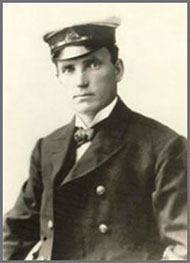The birth of 18ft Skiff Racing as we know it today occurred on Sydney Harbour on 26 January 1892. The father was Mark Foy. Foy was a local businessman who loved sailing and believed Sydney Harbour to be the world’s best aquatic playground, and was disappointed that, unlike many other sports, sailing attracted practically no public interest.
He was quick to realise that the sailors themselves were responsible for this lack of interest as they made no attempt to cater for the public.
They raced over a 12-mile course and were out of sight for up to two hours.
- A complicated handicap system caused a further delay while the winner was being determined later in the clubhouse.
- There was no attempt to entertain spectators while the boats were out of sight.
Determined to change this situation, he discussed the matter with a few close friends and came up with a series of initiatives which he believed would popularise sailing as an exciting spectator sport. His plan was split into three simple steps:
- Racing must be exciting and faster.
- Boats had to be more colourful and more easily identified than by a number on the Sails.
- Race winner should be decided on a first-past-the-post basis.
 The major problem with Foy’s plan was producing a faster racer, but he solved this with the first of the 18-footers, which was an open, centreboard boat with a very light hull, an 8-foot (2.4m) beam and only 30 inches (76cm) amidships. It carried a crew of 14 (compared to the previous boats with 25 crew) and had a huge spread of sail which gave it a sensational aquaplaning speed downwind.
The major problem with Foy’s plan was producing a faster racer, but he solved this with the first of the 18-footers, which was an open, centreboard boat with a very light hull, an 8-foot (2.4m) beam and only 30 inches (76cm) amidships. It carried a crew of 14 (compared to the previous boats with 25 crew) and had a huge spread of sail which gave it a sensational aquaplaning speed downwind.
Foy’s original idea of having striped sails to identify each boat had to be abandoned due to the excessive cost of manufacturing varying designs for registration. His alternative was for each boat to have a colourful emblem on its mainsail - a tradition which continues to this day, although the colourful emblem is now almost exclusively the logo of a corporate sponsor.
When Foy tried to enter his boats with the Anniversary Regatta Committee of 1892, they were rejected as the committee believed that 'such badges were not in keeping with the dignity of the oldest regatta in the southern hemisphere'.
Foy was furious and announced 'we’ll run our own regatta on Anniversary Day. I’ll pay for it and we’ll give the public what it wants'.
High-pressure publicity given to Foy’s plans paid big dividends. On regatta day, Clark Island (Sydney Harbour) was packed to capacity, while moored ferries and jetties provided additional accommodation - as did every vantage point along the foreshores of Sydney Harbour.
The crowd was without precedent in Australian yacht racing although most of these spectators knew little about the sport. The vast majority were there to thrill to the excitement that Foy had promised.
A triangular three miles course was plotted and a 'staggered' start introduced (where the best boats started after the slower boats) to bunch the fleet for a spectacular, downwind run to the finish at Clark Island.
At the start there had been less than three minutes between all boats in the fleet. At the finish there were a dozen boats racing for the line in a bow-to-bow finish.
The public got its moneys worth and the coloured badges of the 18-footers were an instant success.
Foy had demonstrated that 18-footer racing was the most exciting sport ever seen on Sydney Harbour - a status that has never been seriously challenged.
The 18-footer, with a 8ft beam, was manned by a reduced crew of 10-15 men but carried not much less sail area than the bigger boats.
These 18-footers were dinghy type boats and carried mainsail, ballooner, ringtail, topsail, topsail head spinnaker and (at times) watersails. For spectators, they didn’t differ much from the bigger boats but were much less costly to build and maintain.




